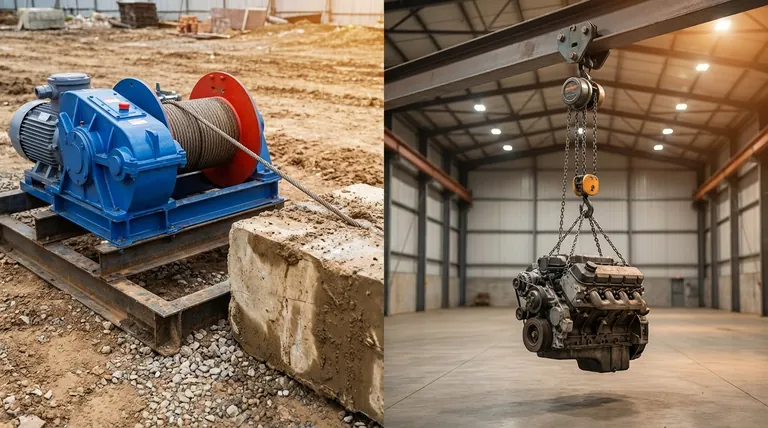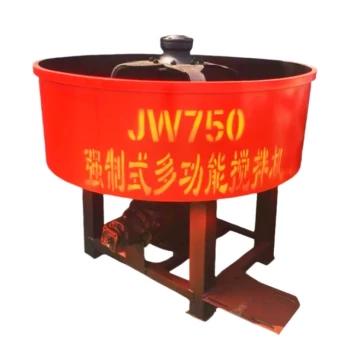At its core, the difference is simple: a winch is designed to pull a load horizontally, while a hoist is designed to lift a load vertically. This fundamental distinction in intended direction dictates their mechanical design, braking systems, and most importantly, their safety features.
The critical takeaway is not just their direction of operation, but the engineering behind it. A hoist is built to safely suspend a heavy load overhead, using braking systems designed to prevent catastrophic failure. A standard winch is not, making it profoundly unsafe to use for vertical lifting.

The Core Design Philosophy: Pulling vs. Lifting
The intended application of each tool shapes every aspect of its construction. Understanding this design philosophy is the first step in selecting the correct and safe piece of equipment for your task.
A Winch's Purpose: Horizontal Pulling
A winch is a pulling machine. Its primary function is to drag a heavy load across a surface, which may be flat or inclined.
Think of tasks like vehicle recovery—pulling a car out of a ditch—or loading a boat onto a trailer. These applications involve immense horizontal force, managed by a wire rope or synthetic cable spooling onto a drum.
A Hoist's Purpose: Vertical Lifting
A hoist is a lifting machine. It is engineered specifically to raise and lower a load, often holding it suspended in a fixed position.
This is common in workshops for lifting engine blocks or on construction sites for moving building materials. The entire design is centered on managing a load against the constant force of gravity, typically from a position directly above it.
Critical Differences in Mechanical Systems
While both may use a motor and cable, their internal mechanics are tailored for their specific jobs. The most significant differences lie in their braking and load management systems.
The Braking System is the Deciding Factor
This is the most crucial distinction for safety. Hoists use mechanical brakes. These are designed to automatically lock and hold the load securely in place the moment power is disengaged. This is an essential safety feature for preventing a suspended load from plummeting.
Many standard winches, particularly those for vehicle recovery, use dynamic brakes. This system uses the motor's resistance to slow and stop the drum, but it is not designed to reliably hold a suspended vertical load. Using a winch with only a dynamic brake to lift something overhead is an invitation for disaster.
Load Management: Drums vs. Lift-Wheels
Winches almost universally use a drum to wind their cable, allowing for very long lengths suitable for long-distance pulling.
Hoists can also use a drum, but many employ a lift-wheel designed to grip a chain. This mechanism is exceptionally well-suited for the precise, controlled movements required in vertical lifting and lowering.
Reach and Mounting Flexibility
Winches typically offer much longer wire ropes or cables, sometimes over 100 meters. This makes them versatile for applications requiring significant reach, such as pulling from a distance or even some rooftop lifting applications (if properly rated).
Electric hoists often have shorter, fixed-length chains or ropes (e.g., 6-12 meters) because they are designed for use in a more constrained vertical space like a workshop or warehouse.
Understanding the Trade-offs and Safety Risks
Confusing these two tools is not just a matter of inefficiency; it's a serious safety hazard.
The Danger of Using a Winch as a Hoist
Never use a standard winch for vertical lifting. The primary risk is brake failure. If the winch's dynamic brake system fails or power is cut, it will not hold the load. The load will fall, posing a severe risk to anyone or anything below.
When Can a Winch Lift a Load?
Some specialized winches are officially rated for lifting. These are built to a higher safety standard and are explicitly equipped with the necessary mechanical braking system found in a hoist. You must always confirm the manufacturer's rating and specifications before even considering a winch for a lifting task.
Using a Hoist for Pulling
While physically possible, using a hoist for horizontal pulling is generally inefficient. It can place an angled, side-loading stress on components that were designed purely for a straight vertical pull, potentially causing premature wear or damage.
Making the Right Choice for Your Task
Your application's direction of force is the only factor that matters. Choosing the wrong tool introduces inefficiency at best and catastrophic risk at worst.
- If your primary focus is vehicle recovery or pulling a load across a surface: A winch is the correct tool, designed for high horizontal pulling forces.
- If your primary focus is lifting a load directly overhead and suspending it: A hoist is the only safe option, engineered with the necessary braking system for vertical safety.
- If your primary focus is lifting, but you require very long reach: You must find a winch that is specifically rated for lifting and explicitly features a mechanical locking brake.
Ultimately, selecting the right equipment is about matching the tool's fundamental design purpose to the physics of your task.
Summary Table:
| Feature | Winch | Hoist |
|---|---|---|
| Primary Function | Horizontal Pulling | Vertical Lifting |
| Key Safety Feature | Dynamic Brake (for pulling) | Mechanical Locking Brake (for holding) |
| Typical Application | Vehicle Recovery, Boat Loading | Workshop Lifting, Construction Sites |
| Critical Safety Risk | Unsafe for overhead lifting | Can be inefficient for horizontal pulling |
Ensure Job Site Safety and Efficiency with the Right Equipment
Choosing between a winch and a hoist is critical for the safety and productivity of your construction or contracting project. Using the wrong tool isn't just inefficient—it's dangerous.
GARLWAY specializes in providing robust and reliable construction machinery, including winches and concrete equipment, tailored for professionals like you. We understand the precise engineering required for safe load handling.
Let our experts help you select the perfect equipment for your specific needs.
Contact GARLWAY today for a consultation and ensure your next project is built on a foundation of safety and performance.
Visual Guide

Related Products
- Electric and Hydraulic Winch for Heavy Duty Applications
- Warn Winch Windlass Boat Trailer Winch
- Electric 120V Boat Winch by Badlands
- Best 18000 Pound Drum Anchor Trailer Winch
- 12000 lb Heavy Duty Electric Boat Winch
People Also Ask
- How does the electric winch work? Unlock the Power of Force Multiplication
- How to power an electric winch on a trailer? Choose the Best Method for Your Setup
- What is the difference between electric winch and electric hoist? Essential Safety & Application Guide
- How is an electric winch powered? Unlock the Power Conversion System for Heavy Lifting
- Can an electric winch be used as a hoist? Understand the Critical Safety Differences



















